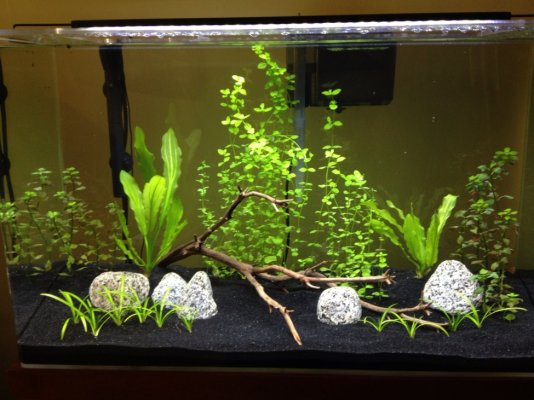Brian_Nano12g
Aquarium Advice Addict
Current Satellite LED+ Fixture Review / Initial Impressions

I. Introduction
Alight ladies and gents, I'm pleased to introduce a new LED fixture I acquired, the Current Satellite LED+ (6,500K / RGB)! There's no mistaking it, LED's are the new kid on the block in this hobby and with all new things, there is always room for innovation and improvements. Technology evolves, new studies come out, and engineers implement new ideas; case in point, this new Current USA's offering. Just keep in mind though, not all LEDs are created equal! Do your research (hint: lookup PAR vs. Distance). Ask questions. Make an informed buying decision!
Here's some quick stats to digest:
24" Current Satellite LED+:
Before I get started, I just want to say that I'm nowhere near being an expert on the subject. In fact, I'm just an average hobbyist who does their fair share of asking questions in the planted tank forums, research, and learn from practical experience. If I misinform here or say something wrong, please comment and correct me... in this hobby, I'm always learning!
It just so happens I'm also a sucker for technology and innovation, and I tend to lean more towards form over function. So coming from an average Joe and my inability to explain my experience beyond the skill level of Laymen's terms, I think this review can help others in deciding whether the new Current Satellite LED+ fixture is for you, as I did.
I need to get one more thing out of the way before I move on the star of the show, the disclaimer!
>>>>>>>>>>>>Filler section and background info. Feel free to Skip down to Initial Impressions!<<<<<<<<<<<
Let's move on..... I have only been in the hobby for a few years, but only got serious about planted tanks a couple years back. Oh, and I also (like many of you perhaps), have a case of MTS...but I digress...moving on! Being that I'm a student and I've always been taught to strive for a "lower carbon footprint" and not be wasteful, yada yada yada... I jumped at the opportunity when I found out about LED's potential to grow aquatic plants! One thing I have noticed with my earlier experience with white LED fixtures geared toward the planted tank genre, they are weak in the "full spectrum" department that makes it challenging for all the wavelengths to penetrate anything deeper than a nano tank. Take for instance the spectral analysis chart (see figure 1) here published by a popular LED lighting (not going to mentioned names here) marketed as "daylight" (6,000K - 10,000K), although the color presented to the human eyes appear white or semi-warm in color, through the façade, it is disproportionately heavy in the blue spectrum (which we don't see, because the visible light doesn't look blue like actinic to us) but falls short everywhere else in terms of reds, greens, etc. There have been numerous studies, just by Googling what effects different spectra have on photosynthesis, that reveal other spectrum other than blue are important and absorbed by the plants in which CO2 is consumed (examples: here and here and here).
Just compare the spectrum to let's say, a tried-and-true broad sprectrum Giesemann midday bulb in figure 1 and an AquaFlora in figure 2 -- the spikes in reds and greens are just absent in the all white "daylight" LED lighting. There are some reds/greens in the spectrum, but not enough to penetrate taller tanks.
But that was then and this is now... not to worry, we're at a new turning point and the evolution of LEDs continue. We're on the cusp of a new generation of LED fixtures... the type that are (drum roll please) FULL SPECTRUM!


Say hello to the new Current USA Satellite LED+! Finally, an affordable LED fixture that has a full spectrum due to the ingenious idea of mixing 6,500K LEDs with RGB LEDs! Kudos to you Current! I don't mean to sound redundant, but I'm really ecstatic here because now my plants are getting their healthy dose of REDS, GREENS, and BLUES from LEDs! And to top it off, it has a wireless remote with preprogrammed modes and memory for storing your own custom color output settings! I'M LOVIN' IT! Not only do you get great color temperature production, but you have the ability to customize it to your liking. Oh man, this fixture is sexy! LOL


>>>>>>>>>End Filler section<<<<<<<<<<<<
II. Initial Impressions
AWESOME!
The Current Sat+ fixture is well made; I really like this new fixture! It feels solid and doesn't get too hot after prolonged use. Further, I find it clever & innovative for Current’s design/engineering team to incorporate 2 rows of (4x) 6500K white LED to every row (2x) of RGB along its entire strip. When all of these LEDs are on simultaneously in "full spectrum" mode, the light produces a natural color that is pleasant to look at.


The black slim aluminum housing looks mighty sleek on top of a rimmed or rimless aquarium. While I'll be using these fixtures in the "full spectrum" mode a majority of the time for the benefit of my plants, I find the added bonuses of the 'fun' lighting modes to be really neat. You can definitely have fun showing it off to your friends as a conversational piece or you can engage your kids in learning about biology and see how the fish behave in different light settings (i.e. lighting storm, moonlight, etc.).


Please excuse the dirty filter pipes... I neglected to clean those...oops! Oh, and the drop checker is actually in the green... I just replaced the reagent and 4dkh solution.

I feel confident that this fixture should provide a boost in the full spectrum arena where my older LED lighting fell short. I would still like to see a spectrum analysis graph from Current in the "full spectrum" mode to compare here, but from the spectral graph I posted earlier and from my experience with white daylight LEDs, the blue wave length is so heavy that the Current Sat+ has to excel in this department by comparison. So aside from the immediate boost in color enhancement from my fish, I noticed improvement in the color reflection in my plants as well. The Angels never looked so GOLDEN, and the Cherry Barbs never looked so RED! Colors just pop and I felt deprived of them up until this point.
III. Positive Signs
I've only been using the two fixtures for about a week from when this initial impressions review was written, but positive signs are on the horizon! Take for instance this comparison picture of the Rotala rotundifolia; notice in the first pic (after my trimming) under a white "daylight" LED, it grew green and straight (it grew like this for months so it's not just after the trimming, FYI). Now under (x2) Current Sat LED+, there's some colors developing and there's some bending with all the leaves pointed up! The Rotala is loving this light and taking it all in! I haven't seen this type of bending in my Rotala since I put in new PC full spectrum bulbs in my 12g. Also notice some reds popping up -- especially in the Persicaria sp. "Kawagoeanum" and Ludwigia Red (which became green under my old LED lighting).
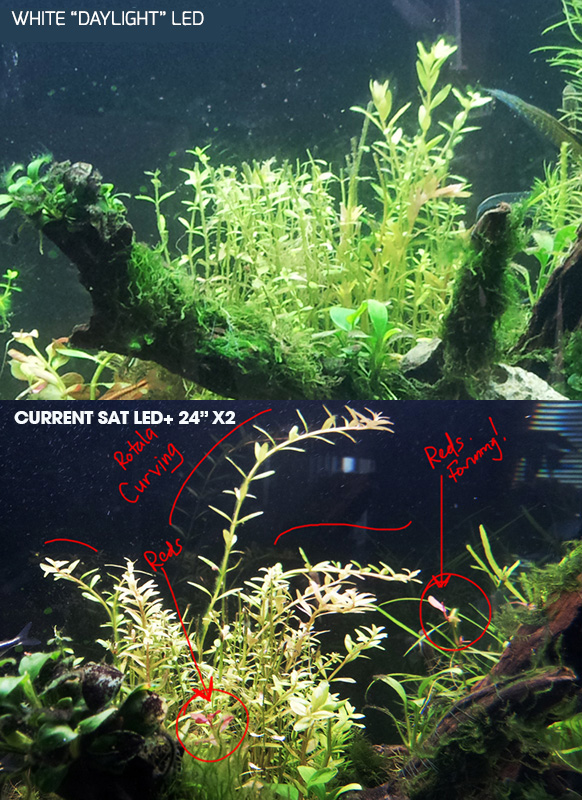

IV. Closing Thoughts
This review is more like an unboxing and an initial impression write-up. It's a little premature for me to make any full claims or assessments. Time will tell at this point. But based on what I'm seeing so far, and coming from only owning a couple of other LED fixtures as my first experience with LED lighting on a planted aquarium, I'm pretty impressed so far! I really like what Current did here and when you factor in how much T5HO fixtures will run you plus bulb replacements and power consumption, this Current LED fixture has great star-potential and makes sense (even if you buy more than one). Just keep in mind though that you'll need to factor in how tall your aquarium is and the type of plants you want to grow to determine if this fixture is for you and if so, how many (also considering CO2, ferts, etc.). In my case, since I'm using it on a 21" tall aquarium (considering about 3" of substrate), two fixtures are needed for the type of plants I have. I would imagine that a single fixture would do fine for low tech setups with low light tolerant plants or fish-only tanks. Or if you were to use a single fixture on a shallow planted tank (e.g. ADA 60-F or 45-F), then it might be suitable for more light demanding plants.
It is my opinion that the Current Satellite LED+ would work great as a stand alone full spectrum solution if you factor in its limitations in intensity or as a supplemental lighting solution to those using all white LED "daylight" fixtures. The former possibly needing multiple fixtures to get the desired PAR/PUR.
I hope this helps and enjoy the additional pictures and video in the coming posts!

I. Introduction
Alight ladies and gents, I'm pleased to introduce a new LED fixture I acquired, the Current Satellite LED+ (6,500K / RGB)! There's no mistaking it, LED's are the new kid on the block in this hobby and with all new things, there is always room for innovation and improvements. Technology evolves, new studies come out, and engineers implement new ideas; case in point, this new Current USA's offering. Just keep in mind though, not all LEDs are created equal! Do your research (hint: lookup PAR vs. Distance). Ask questions. Make an informed buying decision!
Here's some quick stats to digest:
24" Current Satellite LED+:
- 18 watts
- 48 White/24 RGB
- 22.8" x 3.5" x 0.44"
- Aluminum body
- Wireless remote with 6 adjustable preset colors or 12 dynamic light
effects including cloud cover, fading lunar, storm, lightning, dusk and more. - Four memory buttons lets you save your favorite custom color blends.
- Internal memory so the light turns on in the last setting when using a timer.
- Sliding docking legs.
- PAR* value for 1 SAT+ 12" deep is 36 micromols and at 24" is at 21 micromols (*PAR values courtesy of Current's Customer Service; their customer service is stellar by the way).
Before I get started, I just want to say that I'm nowhere near being an expert on the subject. In fact, I'm just an average hobbyist who does their fair share of asking questions in the planted tank forums, research, and learn from practical experience. If I misinform here or say something wrong, please comment and correct me... in this hobby, I'm always learning!
It just so happens I'm also a sucker for technology and innovation, and I tend to lean more towards form over function. So coming from an average Joe and my inability to explain my experience beyond the skill level of Laymen's terms, I think this review can help others in deciding whether the new Current Satellite LED+ fixture is for you, as I did.
I need to get one more thing out of the way before I move on the star of the show, the disclaimer!
Disclaimer:
I do not work for Current USA nor am I affiliated with them. I did not get paid to do this review. This is my first review, so be kind... sorry if it's long too, just tried to be thorough! I'm just an early adopter who saw some potential in new lighting. So There! LOL
I do not work for Current USA nor am I affiliated with them. I did not get paid to do this review. This is my first review, so be kind... sorry if it's long too, just tried to be thorough! I'm just an early adopter who saw some potential in new lighting. So There! LOL
>>>>>>>>>>>>Filler section and background info. Feel free to Skip down to Initial Impressions!<<<<<<<<<<<
Let's move on..... I have only been in the hobby for a few years, but only got serious about planted tanks a couple years back. Oh, and I also (like many of you perhaps), have a case of MTS...but I digress...moving on! Being that I'm a student and I've always been taught to strive for a "lower carbon footprint" and not be wasteful, yada yada yada... I jumped at the opportunity when I found out about LED's potential to grow aquatic plants! One thing I have noticed with my earlier experience with white LED fixtures geared toward the planted tank genre, they are weak in the "full spectrum" department that makes it challenging for all the wavelengths to penetrate anything deeper than a nano tank. Take for instance the spectral analysis chart (see figure 1) here published by a popular LED lighting (not going to mentioned names here) marketed as "daylight" (6,000K - 10,000K), although the color presented to the human eyes appear white or semi-warm in color, through the façade, it is disproportionately heavy in the blue spectrum (which we don't see, because the visible light doesn't look blue like actinic to us) but falls short everywhere else in terms of reds, greens, etc. There have been numerous studies, just by Googling what effects different spectra have on photosynthesis, that reveal other spectrum other than blue are important and absorbed by the plants in which CO2 is consumed (examples: here and here and here).
Just compare the spectrum to let's say, a tried-and-true broad sprectrum Giesemann midday bulb in figure 1 and an AquaFlora in figure 2 -- the spikes in reds and greens are just absent in the all white "daylight" LED lighting. There are some reds/greens in the spectrum, but not enough to penetrate taller tanks.
Figure 1: (top graph is "daylight" LED / bottom broad spectrum T5)
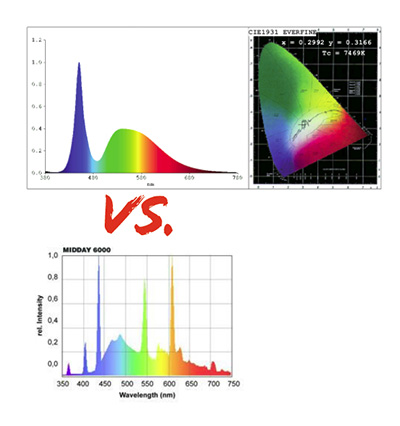
Figure 2:
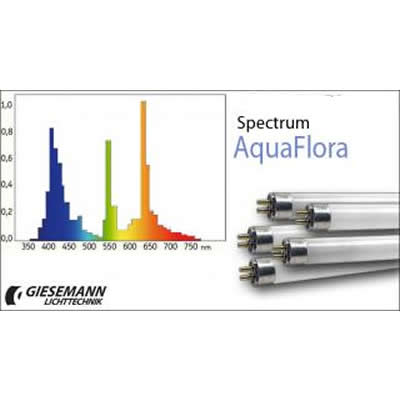
Here's a little factoid for you, white LED's that claim to produce 6,500K to 10,000K are actually BLUE diodes with a yellow-based phosphor. No wonder there's so much blue in the spectrum chart! Here's more of what I dug up... Water acts as a natural light filter, duh! Blue light (460 nm) travels though the depths further than any other wavelength of light (explains high PAR values in some white "daylight" LED lights heavy in blue spectrum). Those of you who SCUBA dive (such as me) would notice that everything looks blue at depths, even colorful fish and corals. Conversely, red light (640 - 700nm) is the first to get filtered out by water, it just can't penetrate as deep! Therefore, what little red is in the spectrum of "daylight" white LEDs are quickly diminished the taller a tank gets. I'm no scientist by any stretch, and what I'm saying is pure conjecture and might sound foolish to some of you... but I believe since individual LED dies, AKA chips, emit light in a specific narrow range of wavelengths, separate LED's in the REDS, GREENS, and BLUES are needed to get the FULL SPECTRUM plants need to grow better (colorful) through photosynthesis and not just green. Plants benefit from a full spectrum light source because it mimics the sun, think a prism or a rainbow; those are the wavelengths hidden to normal human vision but embedded in natural sunlight that the plants just love! Not to knock older LED fixtures that claim "daylight" but all white LED's were just the beginning and we are now starting to see multiple bandwidths/nanometers for full spectrum coverage being implemented in planted tank LED lighting. I kept planted tanks under these very so-called "daylight" LED fixtures alongside my other tanks that had full spectrum fluorescent lighting. IMO, the full spectrum bulbs from traditional fluorescent lighting, whether it be a T5 or PC bulb, made my plants grow better, look better, and appear more colorful. However, I would say the exception to this is if you are going for an all green planted tank such as Iwagumi or Nature style, then these all white "daylight" LEDs are well suited for the task. This becomes problematic when you start considering colorful plants for a Dutch scape or accent colors in a nature scape for example. Just my 2 cents! 
Figure 2:

But that was then and this is now... not to worry, we're at a new turning point and the evolution of LEDs continue. We're on the cusp of a new generation of LED fixtures... the type that are (drum roll please) FULL SPECTRUM!



Say hello to the new Current USA Satellite LED+! Finally, an affordable LED fixture that has a full spectrum due to the ingenious idea of mixing 6,500K LEDs with RGB LEDs! Kudos to you Current! I don't mean to sound redundant, but I'm really ecstatic here because now my plants are getting their healthy dose of REDS, GREENS, and BLUES from LEDs! And to top it off, it has a wireless remote with preprogrammed modes and memory for storing your own custom color output settings! I'M LOVIN' IT! Not only do you get great color temperature production, but you have the ability to customize it to your liking. Oh man, this fixture is sexy! LOL


>>>>>>>>>End Filler section<<<<<<<<<<<<
II. Initial Impressions
AWESOME!
The Current Sat+ fixture is well made; I really like this new fixture! It feels solid and doesn't get too hot after prolonged use. Further, I find it clever & innovative for Current’s design/engineering team to incorporate 2 rows of (4x) 6500K white LED to every row (2x) of RGB along its entire strip. When all of these LEDs are on simultaneously in "full spectrum" mode, the light produces a natural color that is pleasant to look at.


The black slim aluminum housing looks mighty sleek on top of a rimmed or rimless aquarium. While I'll be using these fixtures in the "full spectrum" mode a majority of the time for the benefit of my plants, I find the added bonuses of the 'fun' lighting modes to be really neat. You can definitely have fun showing it off to your friends as a conversational piece or you can engage your kids in learning about biology and see how the fish behave in different light settings (i.e. lighting storm, moonlight, etc.).


Please excuse the dirty filter pipes... I neglected to clean those...oops! Oh, and the drop checker is actually in the green... I just replaced the reagent and 4dkh solution.

I feel confident that this fixture should provide a boost in the full spectrum arena where my older LED lighting fell short. I would still like to see a spectrum analysis graph from Current in the "full spectrum" mode to compare here, but from the spectral graph I posted earlier and from my experience with white daylight LEDs, the blue wave length is so heavy that the Current Sat+ has to excel in this department by comparison. So aside from the immediate boost in color enhancement from my fish, I noticed improvement in the color reflection in my plants as well. The Angels never looked so GOLDEN, and the Cherry Barbs never looked so RED! Colors just pop and I felt deprived of them up until this point.
III. Positive Signs
I've only been using the two fixtures for about a week from when this initial impressions review was written, but positive signs are on the horizon! Take for instance this comparison picture of the Rotala rotundifolia; notice in the first pic (after my trimming) under a white "daylight" LED, it grew green and straight (it grew like this for months so it's not just after the trimming, FYI). Now under (x2) Current Sat LED+, there's some colors developing and there's some bending with all the leaves pointed up! The Rotala is loving this light and taking it all in! I haven't seen this type of bending in my Rotala since I put in new PC full spectrum bulbs in my 12g. Also notice some reds popping up -- especially in the Persicaria sp. "Kawagoeanum" and Ludwigia Red (which became green under my old LED lighting).


IV. Closing Thoughts
This review is more like an unboxing and an initial impression write-up. It's a little premature for me to make any full claims or assessments. Time will tell at this point. But based on what I'm seeing so far, and coming from only owning a couple of other LED fixtures as my first experience with LED lighting on a planted aquarium, I'm pretty impressed so far! I really like what Current did here and when you factor in how much T5HO fixtures will run you plus bulb replacements and power consumption, this Current LED fixture has great star-potential and makes sense (even if you buy more than one). Just keep in mind though that you'll need to factor in how tall your aquarium is and the type of plants you want to grow to determine if this fixture is for you and if so, how many (also considering CO2, ferts, etc.). In my case, since I'm using it on a 21" tall aquarium (considering about 3" of substrate), two fixtures are needed for the type of plants I have. I would imagine that a single fixture would do fine for low tech setups with low light tolerant plants or fish-only tanks. Or if you were to use a single fixture on a shallow planted tank (e.g. ADA 60-F or 45-F), then it might be suitable for more light demanding plants.
It is my opinion that the Current Satellite LED+ would work great as a stand alone full spectrum solution if you factor in its limitations in intensity or as a supplemental lighting solution to those using all white LED "daylight" fixtures. The former possibly needing multiple fixtures to get the desired PAR/PUR.
I hope this helps and enjoy the additional pictures and video in the coming posts!
Last edited:










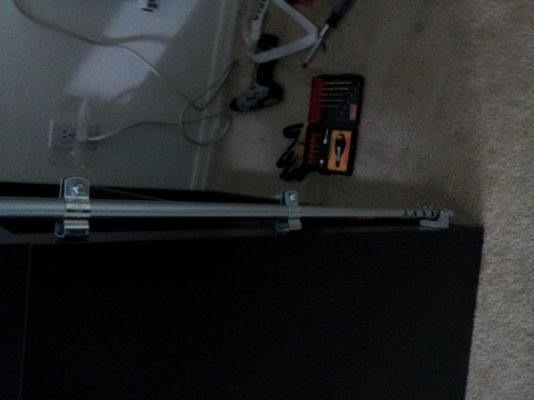



 Thanks again for your great review Brian. It really helped me to make the decision. This is a very nice light that fits my needs perfectly AND it is fun.
Thanks again for your great review Brian. It really helped me to make the decision. This is a very nice light that fits my needs perfectly AND it is fun.